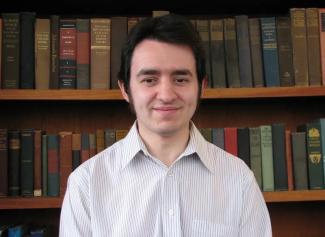
It all began at John Jay’s Homestead: Q and A with Cody Nager
For many historians, there was a memorable catalyst that sparked their interest in studying history. For one of this year’s McNeil Center Fellows, it was a Chinese export porcelain dish set. Cody Nager, a Ph.D. Candidate in the Department of History at the Graduate Center, City University of New York, spoke with us about his research interests and background – as well as the historic artifact that brought him to the study of early America.
Q: What drew you to the study of early America?
Nager: When I was in high school, I volunteered at the John Jay Homestead State Historic Site in Katonah, New York, the retirement home of the first Chief Justice. While there, I led tours, worked alongside the staff on exhibit design, and completed a comprehensive inventory. The chance to interact with period objects (one of my favorites was Jay’s original Chinese export porcelain dish set) and present them to the public encouraged me to pursue the field in college.
Q: How did you become interested in your dissertation topic?
Nager: My dissertation on migration and citizenship in the early Republic and beyond was inspired by my interactions with my students at the City College of New York, many of whom are immigrants or children of immigrants. The questions about immigration policy they raised matched my interests. The reason Jay’s wedding china was so compelling was not only because the set was visually amazing, but it also represented a cross section of the social and political norms of a culture at that time and the connection between the nascent United States and a broader global community. Generally, my scholarly interests focus on how interactions between the diverse people of America and the broader Atlantic world shaped structures of racial inequality, economic development, political rights, and national identity in the United States.
Q: What do you see as some of the challenges or opportunities that early Americanists are working on in the 21st century?
Nager: The field of American migration history presents wonderful opportunities for future scholarship. In many ways, the United States’ migration question is an ongoing one, as each generation seeks to define who counts as the “right” migrant for the nation. This process of reevaluation means that migration history as a field is constantly shifting and open to new scholarly approaches. The subfield of migration in the early Republic is in the midst of a miniature renaissance, with scholars presenting new and compelling views on the underappreciated period in the larger scope of traditional American migration history.
Q: What do you find most enjoyable/rewarding about the research process?
Nager: The most enjoyable part of the research experience is visiting archives, searching boxes of documents, and finding compelling sources, whether brand new or pre-acknowledged that speak to your larger argument. For example, in the process of writing my third chapter, on the Adams administration, I found a few documents concerning a petition from free African Americans of Philadelphia regarding the slave trade which allowed me to form a new perspective on how to connect the Naturalization Act of 1798 and the Slave Trade Act of 1800.
Q: What are you most looking forward to during your Fellowship at the McNeil Center?
Nager: Over the course of my residence at the McNeil Center, I am most looking forward to the chance to interact and collaborate with the other fellows, the numerous compelling speakers at the Brown Bags and seminars, the McNeil staff, and the broader Philadelphia early Americanist community. I am also excited to work with and mentor the undergraduates at the MCEAS Consortium Undergraduate Research Workshop. The McNeil Center fellowship provides the support to develop more compelling and engaged scholarship through interaction with the broader scholarly community.
Cody Nager is an MCEAS Consortium Dissertation Fellow and a Ph.D. Candidate in the Department of History at the Graduate Center, City University of New York.
To learn more about Nager’s work, view his dissertation summary or visit his website.
Stay tuned for more Fellow Profiles in the coming months.

